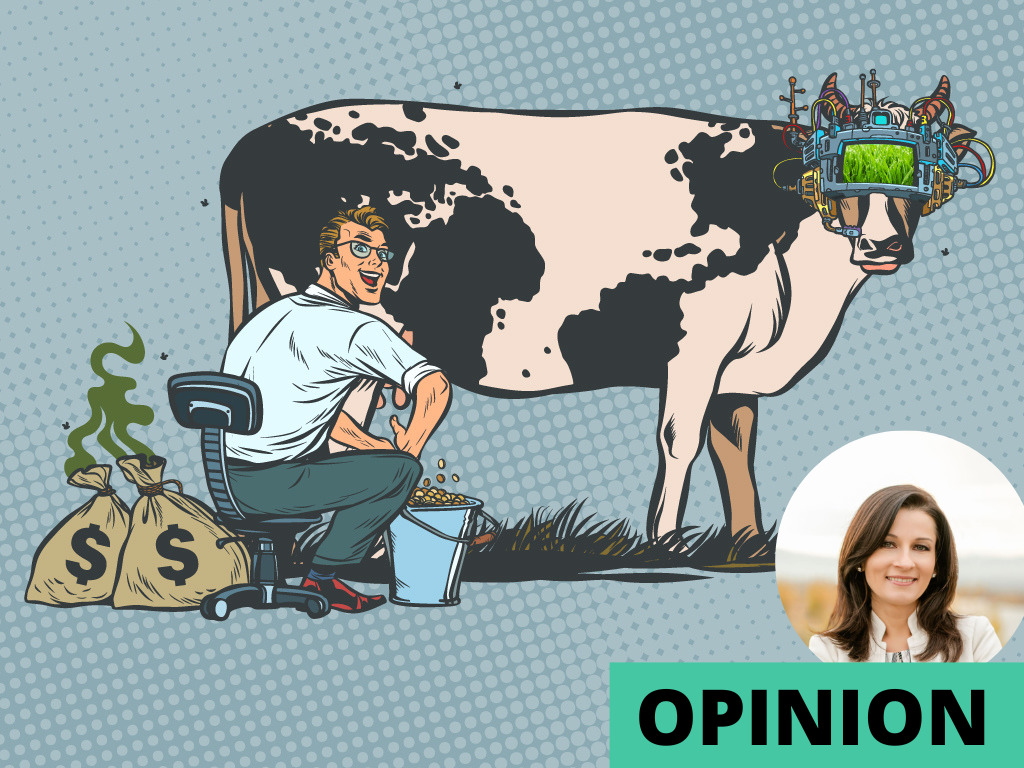8 Mins Read
Notes From the Frontlines of the Sustainable Food Movement – a new opinion column by Irina Gerry
Images of happy cows on pasture hide the ugly truth the dairy industry doesn’t want you to know: dairy production can never be sustainable.
Many of us grew up believing a glass of milk is wholesome and nutritious, and cheese is a delicious natural product that makes just about any dish tastier. We were shown images of happy cows on pastures and told that “milk does a body good”. And yet, there is a darker side to dairy that is hiding behind the marketing veneer.
Did you know that producing 1 liter of milk emits 3.2kg of CO2e. For cheese, that number is 23.9kg of CO2e, which is about equivalent to emissions from burning 10kgs of coal. And that’s just emissions. Dairy production is incredibly water intensive as well. From hay and feed crop irrigation to the water cows drink, to dairy farm operations, an average liter of milk requires 628 liters of water. 1 kg of cheese takes a whopping 5,605 liters to produce. Then, there is a significant amount of land needed for pasture and growing feed for cows.
So, can dairy ever be sustainable?
I don’t believe so, and let me show you why. The core of the issue lies in how milk is made. Cows are mammals, and thus must give birth in order to produce milk. Cows are artificially impregnated as soon as they reach maturity. Once the calf is born it is removed from the mother to be raised separately for slaughter as veal or beef, or to become a “replacement” heifer. The mother cow then goes into “milk production” mode, cycling between feeding stalls and milking stations at the farm 2-3 times daily for 10 months or so, until her milk production begins to wane. Then, a cow may get a 2-month rest period before giving birth to the next calf, and the cycle repeats. A commercial dairy cow is considered “spent” after 4-5 pregnancy cycles and sent to slaughter for meat, marking an end to a rather short and torturous life for the animal.
It is not difficult to empathize with the pain of separating mothers from newborn calves, or the unusual cruelty of using mothers as milk production machines, or with keeping animals in factory farms for the greater part of their short lives as cogs in our food system. This is not natural. This is not kind. This is not necessary.
But, let’s set that aside for a minute and just talk about sustainability.
Feeling the heat from the climate movement, the dairy industry is attempting to improve its sustainability image by investing in “climate-smart” agricultural practices – using crop rotations and reducing tilling on feed cropland, optimizing watering and fertilizer use, investing in seaweed extracts that promise to reduce methane emissions, and installing biogas digesters to help siphon off some of the methane gas from manure lagoons and selling it off as a source of renewable energy.
Could these improvements make dairy sustainable? Let’s look at them one by one.
Feed and Land:
Cows have to be fed. Dairy cows require about 45kg of feed each day. Given the logistics of frequent milking, dairy cows spend the bulk of their lives indoors. A dairy cow may spend a few weeks on pasture between milking cycles, and a few lucky USDA Organic Certified milk cows are required to get 120 days on pasture each year. That’s still only 30%.
Since dairy cows don’t spend much time on pasture, most of the feed is grown offsite. This requires a lot of land, water and fertilizer. In fact, alfalfa hay, a common cow feed crop, is one of the world’s top GMO Roundup-ready crops, sprayed with glyphosate, which causes air and water contamination at an immense scale. Other feed crops, like corn and soy, occupy some of our most productive agricultural lands. Most of them are also of the GMO/Roundup-ready variety, grown on vast mono-crop fields, sprayed with fossil-fuel-based fertilizer, and processed with massive gas-powered combines, ratcheting up emissions associated with milk production and contributing to eutrophication (waterways and ocean pollution).
Overall, it takes about 100 calories of feed to get 17 calories worth of milk, which is highly inefficient, considering that productive croplands could also be used to grow crops for human consumption, as in the case of oat or soy, which can then be used to make plant-based milk. Yes, there are some exclusively grass-fed operations out there, but we should not confuse them with cows on pasture. Even grass-fed cows spend the majority of their time indoors.
Further, the overall resource need for grass-fed cows is actually higher per liter of milk, requiring more land and resources, which reduces the overall effect of carbon offsets provided by grassland. The recently completed life cycle assessment by Organic Valley coop in the U.S. found that they only reduced the net farm emissions by an average of 15% compared to conventional dairy. Not bad, but it is far from being carbon neutral.
The US dairy industry recently received millions in federal funding under the Climate-Smart Commodities program. Many of the projects focus on incremental emissions reduction associated with feed crop production, such as crop rotations, lower tilling and minimizing fertilizer. However, these improvements are not likely to reduce emissions to zero or be able to compensate for the massive tradeoffs in land use. With re-wilding and re-forestation efforts this land could instead serve as a carbon sink instead.
Water:
Dairy farming requires a lot of water. In addition to the water cows drink, which is about 30-50 gallons per day, there is built-in water demand for growing feed. Alfalfa is a top feed crop for cattle. It also happens to be one of the most water-intensive crops worldwide. In the Western United States, we use 32% of our dwindling freshwater supply just to grow grass and alfalfa for cattle, while only 6% is used for 115 million residents. In fact, 20% of all US dairy is produced in California, which is currently in the grips of a megadrought. California cows alone, require about 20% of California’s water supply, draining aquifers and dams. Filtering our water through grass and animals is an incredibly inefficient way to use this scarce resource.
Filtering our water through grass and animals is an incredibly inefficient way to use this scarce resource.
Total dairy water use is typically lower in wetter parts of the world where growing hay may not require irrigation. Limiting production to those areas could create a better water footprint for dairy farming. However, a significant industry scale-down would be required to allow for that limitation. Even with that, dairy production will never bring its demand for water to zero. Oats, soy and many other alternative milks offer a superior water footprint compared to dairy.
Emissions:
In addition to CO2 emissions associated with growing feed and farm operations, cows naturally produce methane as part of their digestion process, and methane is 86 times more powerful at warming the planet than CO2.
The use of seaweed additives in cattle feed to reduce methane emissions is touted in the media as the next big thing to allow us to have our meat and dairy and save the planet, too. Upon closer examination, many studies are based on short-term experiments of just a handful of cows, in factory farm conditions. While the short-term reductions appear promising, touting up to 80-90% reduction, especially for dairy cows, which spend most of their lives in confinement, the overall emissions picture is not that rosy. Feed additives do not address the full scope of emissions associated with dairy farming, such as growing feed crops and other farm or manufacturing operations. DSM’s Bovaer seaweed additive only reduces emissions by 30%, for example. Not bad, but still far from sustainable for a high-emissions industry.
Cow manure is also a source of both methane and nitrous oxide, which is another extremely powerful greenhouse gas. The problem with dairy operations is that manure is not naturally spread on pasture, where grasslands can offset some of the emissions. Since cows spend most of their lives on factory farms, all the manure is washed off the floors into massive manure lagoons, serving as a massive open-air emissions source. Combine that with methane from burps and it is no wonder livestock is responsible for more methane emissions than the oil and gas sector.
As a way of addressing manure emissions, the dairy industry has also received millions in federal and state funding for Biogas Digester installations. Biogas Digesters break down organic waste using bacteria that produce methane. The resulting methane can be collected and combusted to generate electricity. Biogas garnered a lot of positive PR, but overall emissions reductions achieved by this practice represent only a small fraction of the total, and the electricity generated actually costs more to produce than conventional methods.
Classifying biogas as a renewable source of energy, allows industrialized animal agriculture to receive renewable energy incentives, while simultaneously avoiding emissions regulations. Critics came out strongly against using biogas digesters as inefficient, lose-lose propositions for both climate and animals. So far in the US, Biogas Digesters reduced emissions by 6 MMT of CO2e out of 245 MMT of CO2e from livestock. This is hardly impressive.
While all of these sustainability improvement initiatives appear promising, they are ultimately incremental improvements to an unsustainable system.
While all of these sustainability improvement initiatives appear promising, they are ultimately incremental improvements to an unsustainable system. There is no evidence to suggest that even when fully implemented and combined with one another they have any chance of erasing the massive climate footprint of milk production. From the latest UN IPCC report, all livestock emissions reduction technologies combined could reduce emissions by 3-34%, leaving the vast majority unabated.
Putting together emissions, high water and land use, deforestation, biodiversity loss and waterways pollution, it becomes impossible to imagine a path to real sustainability for dairy.
The Verdict
This leads me to conclude that sustainable dairy at scale is not possible. Given the fact that we have so many delicious plant-based alternatives to dairy, and animal-free options coming soon, it is time to turn the conversation away from attempting to implement incremental fixes to the unsustainable industry and instead focus on building new ways to satisfy consumer demand for delicious and nutritious dairy foods made entirely without the use of animals.
Lead image courtesy of Irina Gerry.




